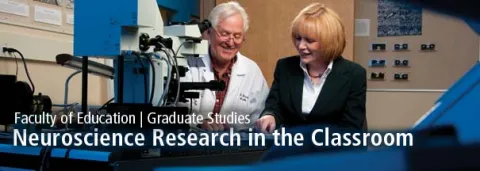Neuroscience Research in the Classroom

Spearheaded by Drs. Nancy Grigg, Robert Sutherland, and Bryan Kolb, University of Lethbridge Education and Neuroscience Experts Collaborate to Launch Unique Masters Degree Program for Teachers
One of former Faculty of Education Dean Jane O’Dea’s long-awaited visions has finally become a reality with the recent launch of the Inclusive Education and Neuroscience M.Ed program. Recalling their early discussions about her desire to expose teachers to the principles of brain development, Dr. Bryan Kolb says, “Jane was eager to take the knowledge that we were generating and somehow apply it to classroom practice.”
This three-year program, the first of its kind in Western Canada, is intended for practicing teachers as well as administrative and leadership professionals. Students in the program will explore the direct application of this neuroscience research to the classroom. “The whole premise of the program is to take the research and apply it to teaching practices in the classroom “ says Sue Bengry, former Director of Student Services, Lethbridge School District 51.
Teachers “need to know about the principles of brain development in order to understand the impact these processes have on behaviours,” Kolb says. Whereas “most of the body develops from a genetic blueprint, the brain develops in response to experiences. So you are your brain.”
“Teachers are eager to learn about the newest neuroscience findings and how these findings might influence our instructional practices and the design of classroom environments,” says Dr. Nancy Grigg. “In the past, we could only assume that kids with learning disabilities had neurological damage or dysfunction.”
Having a foundation in brain-based learning will allow educators to adapt their teaching methods to ensure the best results; essentially providing students with practical “work-arounds,” to their learning challenges. Although this particular program is geared towards experienced teachers, “down the road it would be useful to have all education students taking neuropsychology courses,” says Kolb.
Translating research into practice is, of course, a complex process. “But when educators and neuroscientists begin to work together, the gap between neuroscience research and classroom practice starts to close,” says Grigg.
Policy makers, educators and parents have also been wrestling with the issue of how to better deliver inclusive education. In 2007, Alberta Education conducted a review of the existing practices.
Two years later, a public discussion was launched to consider the future of education as a whole, “Inspiring Education: A Dialogue with Albertans.” Moreover, a whole new “project” was established to create a proposed framework for replacing the current special education system with an “inclusive education system.”
The formulation of this “Setting the Direction Framework,” and its subsequent presentation to the Minister was a resounding success, for until recently there has been little or no consensus on these matters. “Although there has always been a strong philosophical push towards students with special educational needs spending most or all of their time with non-disabled students, implementation of this practice has varied,” Grigg explains.
Clearly, support for inclusive education is strong on all fronts, and the discipline of neuropsychology will undoubtedly continue to infuse the movement with the data it requires to grow and remain confident. We have been preparing for this moment and are proud to witness the Department of Neuroscience and the Faculty of Education boldly step forward in partnership, better prepared to educate today’s educators.
“Every teacher needs to have some understanding of how children learn and I’m not surprised that the U of L, a leader in teacher education, is moving in this direction. With its expertise and small size, this school has the ability to adapt to changes more easily than traditional institutions,” says former Education Minister, Dave Hancock.
Click here to see Dr. Bryan Kolb lecture on Neuroscience in the classroom
